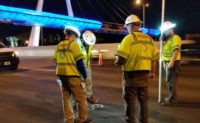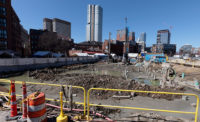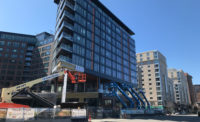A sweeping set of new standards from the American National Standards Institute, for operators, supervisors and owners of boom and scissor lifts and under-bridge inspection platforms, are now poised to go into effect March 1, more than a year after it was first rolled out.
The standards, which typically are adopted by or referenced in a wide variety of safety codes and regulations, deal with both operation and the training for use of the equipment.
New safety and fall protection standards and regulations usually take years to develop and sometimes get hung up in appeals or even litigation. The American National Standards Institute review board had previously pegged December 2019 as the effective date, but postponed the final implementation after a pair of appeals by a major equipment rental association and a large equipment distributor.
Even the name has been revised: ANSI now refers to the equipment formally known as aerial work platforms as mobile elevating work platforms (MEWPs).
The three new standards deal with equipment design, safety requirements and test methods. They also cover training requirements not only for operating the equipment, but also for inspecting, testing and maintaining it. Mark Gates, who works in training and product support for Toyota Material Handling in California, noted in a blog post that the new standards “are designed to enhance safety and shift North American equipment standards closer to international standards.”
The three standards involved—A92.20, A92.22, and A92.24—are slated to replace predecessors that are now more than a decade old.
ANSI Standard 92.22 deals with the safe use of boom lifts, electric scissor lifts and vertical lifts.
Both owners and companies who simply rent mobile platforms are required under the new rules to draw up a site safety and risk assessment plan, which, in turn, must be shared with everyone at the jobsite. The risk assessment must include five different elements. They include scoping out the work, describing where it will be performed and when. The risk assessment must also include an explanation of the equipment chosen for the job—boom, scissor or vertical lift—followed by an evaluation of ways to reduce risks. Some examples include avoiding power lines, staying within the rated height of the equipment and keeping workers on the ground safe.
Additional requirements include a review by the project staff of safe work procedures, including fall safety systems and training. Communication is also required. This means checking whether the operator is trained and authorized to use the equipment and posting a supervisor nearby to oversee the operations. The new standards also require having a rescue plan ready if a worker falls or if the machine fails or the platform becomes entangled.
Further, the plan need to be shared with workers on a jobsite. It must be written out and included in a company’s training manual.
ANSI Standard A92.24 lays out extensive new training requirements, including for “occupants,” defined as anyone on a platform who is not an operator and for supervisors.
Occupants must now learn about fall protection systems and steps to take if the operator is for some reason no longer able to run the lift. Operators, when using a new lift, now must also take steps to ensure they know how to use it, by reading the operating manual, understanding what the equipment can and can’t do and conducting a walk-around inspection.
Under the new training standard, supervisors who oversee one or more aerial lifts are now also required to have safety training as well, including how to decide what lift is right for what job and the potential safety hazards of each machine.
New Design Requirements
Meanwhile, the new ANSI A92 standards spell out several new design requirements for aerial lift manufacturers. They include a gated entrance to the work area. Platform railings now must be more than 43 in. high, from the 30 in. previously required. For some equipment, standard writers reduced lift and load speeds. Additionally, solid or foam-filled tires must be used in rough terrain.
The implementation of the new standards was delayed from December to this coming March in order to make important revisions, which deal with the way design modifications are proposed and the removal of a requirement that a manual of responsibilities be included with each machine.
“It’s about a page of revisions,” wrote DeAnna Martin, executive director and ANSI liaison for the Scaffold & Access Industry Association in a statement. “These are significant revisions. Our ballot passed and now we’re in a 30-day appeals period.”
The American Rental Association successfully appealed plans to require that each new work platform come with a manual of responsibility and that the manual be maintained by the owner.
“This is a huge win for the equipment and event rental industry,” John McClelland, the rental association’s vice president for government affairs, stated in Rental Pulse, the organization’s official publication. Various sources charge from $7 to $8 per copy for the manual, according to industry websites. And with nearly one million work platforms owned by rental companies, the requirement [that each work platform have a manual of responsibility] on it amounted to a significant financial burden on the industry,” said McClelland.
While the requirement for that each work platform come with its own formal operating manual has been pulled, there is still a requirement for some sort of operating instructions. The new requirement allows an "equivalent" instruction booklet to be substituted for the $7 to $8 manual.
Equipment distributor Tutus Solutions appealed a provision that would have restricted modifications or additions to mobile platforms to the manufacturer. Tutus argued the process would shut out the expertise of engineers with experience in aerial lifts but who are not employed by a particular manufacturer.
That appeal was only partly successful. While the changes are no longer restricted to manufacturers, the standard still requires that the owner or engineer seek permission from the manufacturer for any change. If that is not forthcoming due to the company having gone out of business or some other reason, the owner or engineer can get approval from a designated equivalent organization, with an engineer's sign off needed.
This story was updated Jan. 8, 2020 to clarify what the new standard requires as far as manuals of responsibilities, operating instruction manuals and the permission required to make changes to the mobile elevating work platforms.





